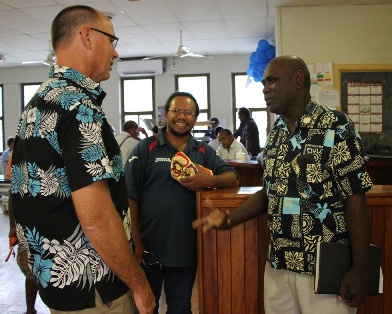25 July 2014
From the High Commissioner's Desk
As I spend more time in Solomon Islands, I’m struck by the amazing ability of Solomon Islanders to achieve so much with limited resources. My visit to the National Referral Hospital (NRH) last Friday was a case in point.
Every year the staff at NRH deliver 6,000 babies, care for more than 12,000 in-patients and more than 60,000 outpatients and fill nearly 100,000 prescriptions for medicines. While touring NRH last week I met Dr Aaron Oritaimae, whose hardworking radiology team has produced more than 10,000 X-rays and scans since February. I saw first-hand the dedication of doctors, nurses, pharmacists and many others, working tirelessly to bring better health care to Solomon Islanders.
Many readers might be surprised to learn that Solomon Islands enjoys better national health indicators than its Melanesian neighbours. Malaria rates and numbers of maternal and child deaths continue to decline. In large part that’s a testament to the hard work and dedication of those in the health sector. But it’s also a reflection of the fact that – to its great credit - the Solomon Islands Government spends more of its budget on health care than many other Pacific countries. Australia is supplementing this effort, spending A$20 million per year on health in Solomon Islands.
But even so, it’s clear that NRH is straining to meet demand for services as the population grows, more people move to Honiara and more patients present with non-communicable diseases which are difficult and expensive to treat. The NRH is also product of history, not of planning. The water and wastewater system is in disrepair and many wards have deteriorated.
Australia is helping to fix this. We’re about to start work on renovating the termite-infested post-natal ward, which will allow at-risk mothers to stay overnight for observation after delivery. Australian-funded water engineers are helping to plan for a better water and sewage system to ensure the safety and health of patients. And we’ve offered a suite of other measures which, if accepted by the Government, will hopefully help the NRH’s management further improve the quality of the hospital. These include a hospital management specialist, a new laboratory and a twinning program with Australian colleges of surgeons and nursing.

High Commissioner Andrew Byrne toured the National Referral Hospital last Friday. Mr Byrne met with the hardworking doctors at the hospital, including Dr Kenton Sade and Dr Rooney Jagilly.
***
This week I was honoured to co-chair the annual bilateral consultations between the Australia and Solomon Islands to discuss our aid program. We’ve seen a lot of changes over the past year, including the transition of RAMSI’s development programs into the High Commission, the merger between DFAT and AusAID and the release of our Government’s new aid paradigm.
Of course, we also saw terrible floods in April and their serious impact on the economy and budget. And our aid program in Solomon Islands has seen some real successes, some areas where we can do better and a handful of exciting new initiatives.
It was terrific to discuss all these matters with a wide array of senior Solomon Islands public servants, in an atmosphere of cooperation, friendship and optimism.
***
Over the past week many readers, like me, will have been watching with a mix of horror and frustration the terrible events in Ukraine after the downing of Malaysian Airlines flight MH17. I’ve been touched by the many expressions of sympathy I’ve received from Solomon Islanders for the loss of so many Australians. For those who might wish to express their thoughts in writing, there will be a condolence book at the High Commission from 9.00am to 1.00pm daily until next Wednesday. The book will then be sent to Australia and, in due course, its messages will be shared with the families of the victims.
This article by High Commissioner Andrew Byrne is one of a series of articles that is published every two weeks in the local papers.
